INSTITUT SUPERIEUR D'ANTHROPOLOGIE
INSTITUTE OF ANTHROPOLOGY
ONLINE COURSES / COURS A DISTANCE
INSCRIPTION 2012 / Session III : Juillet 2012
REGISTRATION 2012 / Term III : July 2012
ROYAUME UNI - 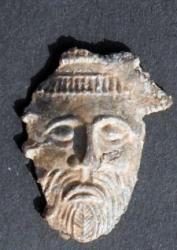
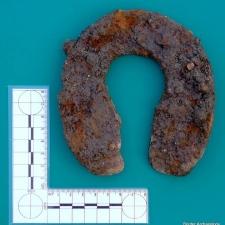 Axbridge – An archaeological discovery has been unearthed at the site of a routine water main replacement in Somerset. Bristol Water has found a piece of horse furniture known as the ‘green man’ from excavations on Axbridge Moor during a £1.3million water pipe upgrade in the area. Archaeologists employed by the company during the work discovered the item, thought to be a decorative part of a horse’s saddle, reins or headgear and a famous, mysterious pagan symbol of fertility. A shard of pottery dated between 100-300BC was also found, as well as 15th century pottery and evidence of an early harbour. The unearthing of horseshoes will also help history buffs learn about farming through the ages, providing evidence of agriculture in the area having existed for 10 centuries.
Axbridge – An archaeological discovery has been unearthed at the site of a routine water main replacement in Somerset. Bristol Water has found a piece of horse furniture known as the ‘green man’ from excavations on Axbridge Moor during a £1.3million water pipe upgrade in the area. Archaeologists employed by the company during the work discovered the item, thought to be a decorative part of a horse’s saddle, reins or headgear and a famous, mysterious pagan symbol of fertility. A shard of pottery dated between 100-300BC was also found, as well as 15th century pottery and evidence of an early harbour. The unearthing of horseshoes will also help history buffs learn about farming through the ages, providing evidence of agriculture in the area having existed for 10 centuries.
http://www.thewestonmercury.co.uk/news/historic_finds_in_new_water_main_dig_1_1450223
ROYAUME UNI – 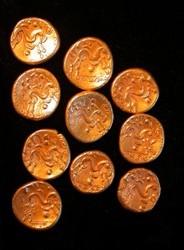 Peatling Magna - This hoard of ten gold Iron Age coins was found in 2010 by Steve Bestwick whilst metal detecting on fields near Peatling Magna, in the District of Harborough. They will be displayed permanently at Harborough Museum from Tuesday 17 July 2012. The coins were probably produced between 60-50 BC in Gallia Belgica, the Latin name for modern north western France and the Low Countries. They show a stylised horse moving right, surrounded by symbols on one side and are blank on the other. It is rare to find hoards of early imported coins so far north, others are confined to East Anglia and the South East. Most Gallo-Belgic coins are found in hoards and usually in mint condition. We think they may have been considered special because they were imported or perhaps they were hoarded because they were better quality gold than local coins.
Peatling Magna - This hoard of ten gold Iron Age coins was found in 2010 by Steve Bestwick whilst metal detecting on fields near Peatling Magna, in the District of Harborough. They will be displayed permanently at Harborough Museum from Tuesday 17 July 2012. The coins were probably produced between 60-50 BC in Gallia Belgica, the Latin name for modern north western France and the Low Countries. They show a stylised horse moving right, surrounded by symbols on one side and are blank on the other. It is rare to find hoards of early imported coins so far north, others are confined to East Anglia and the South East. Most Gallo-Belgic coins are found in hoards and usually in mint condition. We think they may have been considered special because they were imported or perhaps they were hoarded because they were better quality gold than local coins.
VIDEO = http://www.harboroughmail.co.uk/news/features/video-new-museum-display-is-a-real-dazzler-1-4073295
ROYAUME UNI - 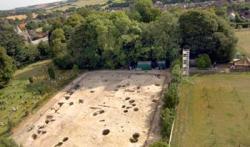 Lyminge - Archaeologists searching for evidence of everyday life in Lyminge from 1,000 years ago will start a new three-year-project this month. The foundations of a monastery church were revealed by a Victorian antiquarian, the Rev R C Jenkins, rector of Lyminge in the 1850s, close to the current St Mary and St Ethelburga Church, which dates back to Norman times. Now, 160 years after Jenkins's excavations, a series of digs will be carried out by archaeologists from Reading University, supported by volunteers from the Kent Archaeological Society and staff from the Canterbury Archaeological Trust. Project leader Dr Gabor Thomas, Reading's lecturer in early medieval archaeology, believes the site could be the first to give a comprehensive view of daily life in an Anglo-Saxon monastery in Kent. He said: "The history of the site spans 300 years, covering the pre-monastic period in the 6th and 7th centuries and the period after the monastery was founded, up until its abandonment in the ninth century, when coastal areas of Kent were ravaged by a series of Viking raids. "I'm confident we're going to find important evidence of the Anglo-Saxon occupation of Lyminge." Work will take place at the site from July 22 until September 2 this year, with further phases every summer until 2014.
Lyminge - Archaeologists searching for evidence of everyday life in Lyminge from 1,000 years ago will start a new three-year-project this month. The foundations of a monastery church were revealed by a Victorian antiquarian, the Rev R C Jenkins, rector of Lyminge in the 1850s, close to the current St Mary and St Ethelburga Church, which dates back to Norman times. Now, 160 years after Jenkins's excavations, a series of digs will be carried out by archaeologists from Reading University, supported by volunteers from the Kent Archaeological Society and staff from the Canterbury Archaeological Trust. Project leader Dr Gabor Thomas, Reading's lecturer in early medieval archaeology, believes the site could be the first to give a comprehensive view of daily life in an Anglo-Saxon monastery in Kent. He said: "The history of the site spans 300 years, covering the pre-monastic period in the 6th and 7th centuries and the period after the monastery was founded, up until its abandonment in the ninth century, when coastal areas of Kent were ravaged by a series of Viking raids. "I'm confident we're going to find important evidence of the Anglo-Saxon occupation of Lyminge." Work will take place at the site from July 22 until September 2 this year, with further phases every summer until 2014.
http://www.thisiskent.co.uk/Church-dig-begin/story-16561709-detail/story.html
USA – 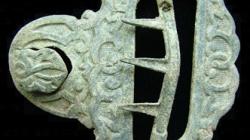 Virginia City - The University of Nevada, Reno, in cooperation with the Nevada State Historic Preservation Office, is sending a team of archaeologists to excavate the site of one of Nevada’s most important early hospitals. St. Mary Louise Hospital in Virginia City opened in 1876 and served the mining community until the early 20th century. The Daughters of Charity opened the hospital as a Catholic facility, although the institution accepted patrons of any faith. They wore a distinctive habit with a starched cornette on the head, made famous in the late-1960s television show, “The Flying Nun.” The order had an active vocation that sought to administer to people in need. Opening an orphanage and school, and then operating a hospital in what was a remote mining community, fit nicely with the mission of the Daughters. The excavation of the St. Mary Louise Hospital grounds continues a tradition dating back to 1990 of University of Nevada, Reno archaeologists working with support from the Historic Preservation Office and the Comstock Historic District Commission to examine resources in Virginia City. Previous excavations included work at Piper’s Opera House, an African American saloon, Chinatown and a residential neighborhood known as Cornish Row. The discoveries of the archaeologists have been made available to the public through tours, exhibits, websites, lectures and publications.
Virginia City - The University of Nevada, Reno, in cooperation with the Nevada State Historic Preservation Office, is sending a team of archaeologists to excavate the site of one of Nevada’s most important early hospitals. St. Mary Louise Hospital in Virginia City opened in 1876 and served the mining community until the early 20th century. The Daughters of Charity opened the hospital as a Catholic facility, although the institution accepted patrons of any faith. They wore a distinctive habit with a starched cornette on the head, made famous in the late-1960s television show, “The Flying Nun.” The order had an active vocation that sought to administer to people in need. Opening an orphanage and school, and then operating a hospital in what was a remote mining community, fit nicely with the mission of the Daughters. The excavation of the St. Mary Louise Hospital grounds continues a tradition dating back to 1990 of University of Nevada, Reno archaeologists working with support from the Historic Preservation Office and the Comstock Historic District Commission to examine resources in Virginia City. Previous excavations included work at Piper’s Opera House, an African American saloon, Chinatown and a residential neighborhood known as Cornish Row. The discoveries of the archaeologists have been made available to the public through tours, exhibits, websites, lectures and publications.
http://www.mynews4.com/news/local/story/UNR-archeologist-to-lead-Virginia-City-hospital/prNn9z6ylk6nCJMJczHJQw.cspx
EGYPTE - 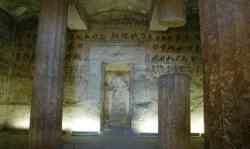 Beni Hassan - Eight years after giving the go-ahead for the National Project to Document Egypt’s Heritage, Beni Hassan necropolis in the Upper Egyptian town of Minya has become the first site on the list to be documented. The Ministry of State for Antiquities (MSA) is responsible for archaeologically documenting Egypt’s cultural and historical heritage, in an attempt to protect and preserve it, as well as providing comprehensive and detailed studies of every site and monument in Egypt for researchers and students in the field. Ahmed Saeed, professor of ancient Egyptian civilisation at Cairo University, stated that the Beni Hassan necropolis is the first archaeological site to be documented, and many are still on the list. He said that Egyptologists had focused their documentation work on the 12 out of 39 tombs within the necropolis which are complete and have distinguished wall paintings and architecture. Beni Hassan is an ancient Egyptian necropolis located approximately 20 kilometres to the south of Minya. It includes 39 rock-hewn tombs, some of which belong to the Old Kingdom, but the majority are dated to the Middle Kingdom. Only 12 tombs are decorated and most were left unfinished. The best examples belong to the local "nomarchs" (governors) from the Middle Kingdom. The necropolis is located on the eastern bank of the Nile, overlooking the river valley with magnificent views in both directions. A temple constructed by Queen Hatshepsut and Thutmose III dedicated to the local goddess Pakhet was found to the south of the necropolis.
Beni Hassan - Eight years after giving the go-ahead for the National Project to Document Egypt’s Heritage, Beni Hassan necropolis in the Upper Egyptian town of Minya has become the first site on the list to be documented. The Ministry of State for Antiquities (MSA) is responsible for archaeologically documenting Egypt’s cultural and historical heritage, in an attempt to protect and preserve it, as well as providing comprehensive and detailed studies of every site and monument in Egypt for researchers and students in the field. Ahmed Saeed, professor of ancient Egyptian civilisation at Cairo University, stated that the Beni Hassan necropolis is the first archaeological site to be documented, and many are still on the list. He said that Egyptologists had focused their documentation work on the 12 out of 39 tombs within the necropolis which are complete and have distinguished wall paintings and architecture. Beni Hassan is an ancient Egyptian necropolis located approximately 20 kilometres to the south of Minya. It includes 39 rock-hewn tombs, some of which belong to the Old Kingdom, but the majority are dated to the Middle Kingdom. Only 12 tombs are decorated and most were left unfinished. The best examples belong to the local "nomarchs" (governors) from the Middle Kingdom. The necropolis is located on the eastern bank of the Nile, overlooking the river valley with magnificent views in both directions. A temple constructed by Queen Hatshepsut and Thutmose III dedicated to the local goddess Pakhet was found to the south of the necropolis.
http://english.ahram.org.eg/NewsContent/9/40/46726/Heritage/Ancient-Egypt/Major-project-to-document-all-Egypts-sites-starts-.aspx